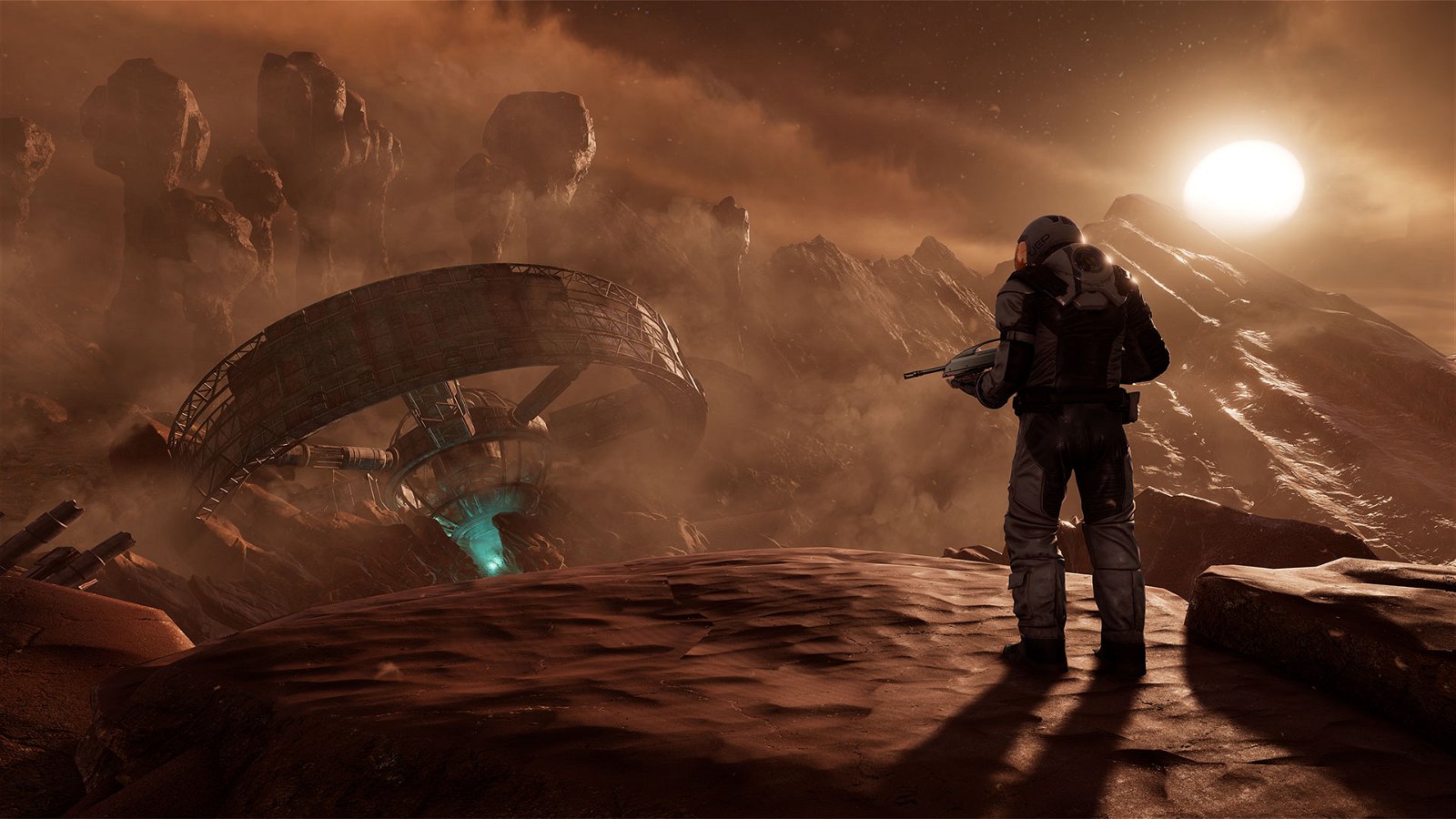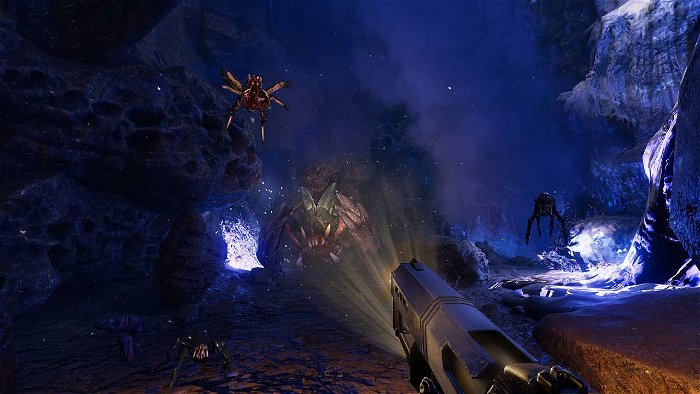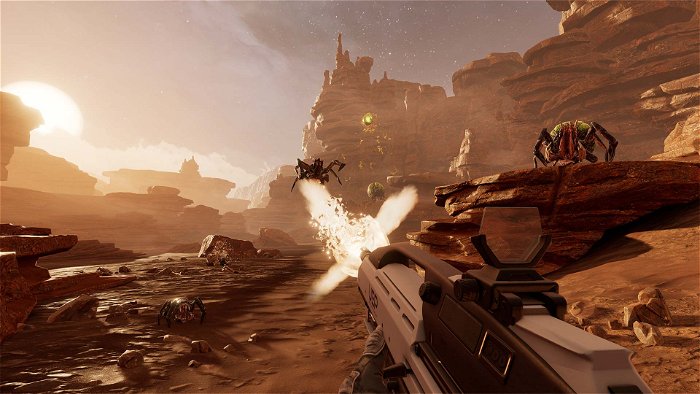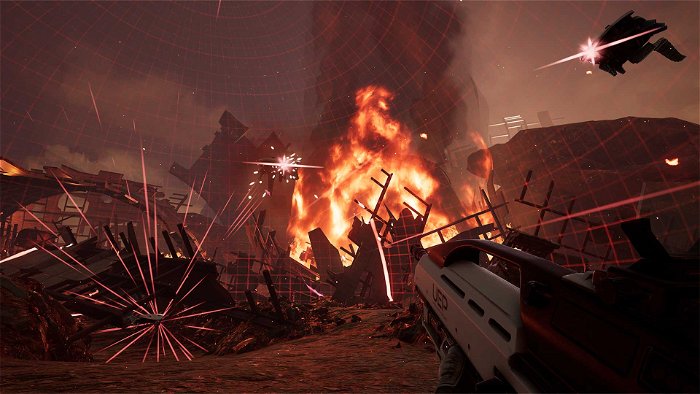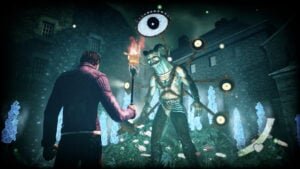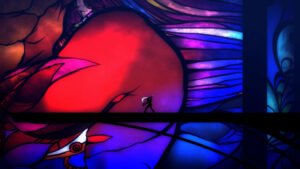Virtual Reality is changing the face of video games, and while a lot of focus tends to fall on its visual aspects, composing the perfect soundtrack is also vitally important in maintaining an immersive virtual gaming experience.
Farpoint is an impressive first-person shooter for the PlayStation VR. Players will experience alien landscapes and, well, shoot spiders. Steve Cox and Danny McIntyre of Unified Sounds built the soundtrack for Farpoint, and were kind enough to talk to CGM about their history with the medium, what makes VR different from a normal gaming experience, and the importance of storytelling from a musical perspective.
CGMagazine: You guys composed to music for Farpoint, but can you tell us more about the history of Unified Sounds?
Steve Cox: I’m the lead composer of Farpoint, the awesome VR game where you blow up spiders (I still play it, way too often). I started a company with Danny, my partner in crime, around 2012, so not too long ago. We joined forces and started collecting amazing composers and producers, and produced Unified Sounds to handle a lot of the TV work we were getting like CBS Sports. Ever since, we’ve just been doing a lot of exciting work, and once Sony came along it got super exciting. Oh, by the way, I’m a composer.
Danny McIntyre: I’m also a composer and producer, I started working with Steve just a little bit before Unified Sounds came to fruition. We did a bunch of collaborations for CBS Sports, which is one of the main things we contribute to compositionally, and we have a number of writers who work under us and for us and with us and we do everything from Video Games to sports music to TV to background music. Everything, you name it. We’ve got really strong composers that do their thing in different genres. I’ve been working with Steve since about 2010, and we also worked at Full Sail University. He used to teach there and I’m the department chair there. We very much have our fingers on the pulse as to whatever’s new and cool and hot so we can share it with our students.
CGMagazine: Have you guys done much video game work prior to Farpoint?
Danny McIntyre: Actually, yeah; applications, put it that way. We have a few members, one member in particular Michael Schiciano, who is credited on Farpoint as well. He has quite a thick mobile game background, so we were able to pick his brains quite a bit and process that. Farpoint is definitely the first and biggest game opportunity that we’ve had. We have done some sound design and also some trailers for a different game a few years before this one. It was a game called Depth, and they actually recorded me in a swimming pool with my scuba gear for some sound design stuff, and then Steve and I scored the trailers to those three videos that came out. I think aside from that, Steve is right that Farpoint is the first really big game that we’ve worked on. But really, I consider it all kind of the same, in the end, it’s just storytelling.
CGMagazine: How do approach scoring a game compared to other media?
Danny McIntyre: As I was saying before, it’s really a matter of storytelling. With any scoring for media, the composer has to first figure out the sound palette of the universe. It could be a television show, it could be a movie, it could be a video game. But once you have that the rest is kind of done. It’s just a matter of developing those ideas and the only difference between them is the deliverables, we might have to send in multiple versions of one thing for a video game or we might only have to send in a 30-second clip for a movie. It’s just a matter of what does the client want physically from us, but emotionally it’s all very the same. How can we set … the stage for the story to take place … and manipulate [that] over time.
Steve Cox: If there’s any difference between game writing and film and other media, it’s the whole nonlinear aspect. It sort of starts that way with a film in the beginning, you’re sketching out scenes and the tentpole pieces for the emotional content, but after that you really have to lock down the timeline, where the score is going to progress in a linear fashion, and being disconnected from that whole ball and chain during a game writing process is really freeing in a lot of ways. You get to experiment, and I really enjoyed the creative aspect of being untethered from the timeline. I think the sound palette was more important with Farpoint … than [for] any film or TV show I’ve done. Finding the right instrumentation, the right vibe, and the right world. You’re really writing to the atmosphere first and foremost, and then after that, it’s the storytelling that kicks in and takes over the composition process. It’s a lot of fun.
CGMagazine: How long does your process typically take?
Steve Cox: It was about nine months, maybe a little longer. We did the demo and it was pretty quick that we got the response back, maybe a week or two. That was back in February and we really didn’t kick it off until the end of March, and then [we] were more or less done at the end of the year on our part. We still had the soundtrack, we still had quite a lot of mixing that went into 2017, but as for composition and the heavy lifting, that was more or less wrapped in nine months. There are also a lot of gaps in there. We’d finish a chunk that was asked of us, but [then] the developers had to basically lay down the tracks for the next part, so we’d have to wait for that to be laid down before we continued working. If we compressed the time, it probably didn’t take us that much time, but it was spread out over the nine months because the whole thing was being built from scratch.
CGMagazine: Is doing music for VR different in any way? Is that something you guys take into account when writing the music?
Steve Cox: I think in the beginning it was kind of like a “that’s a thing we’ll address later in the mix, we’ll fix that in post” but it was really two tiers in that we realized that this is very important in how thick the instrumentation is going to be, how sparse, how the ambiance should envelop the listener—and I’m talking about the musical ambiance, not just the background sound effects, which Sony handled and did great with all the sound design. During the process, it felt like the sound design and the music were kind of one and the same for a while a there. We were trying to create a palette of rich textures that could … [work] as an alien background to a planet, [so] when it came to mixing and implementation it was very different, very specific, very pinpoint. That required some tricky deliverables—more so than a normal game or film.
Danny McIntyre: Steve nailed it. Especially, in the end, it was where Steve really shined.
CGMagazine: Where did you guys look for influence when making this?
Danny McIntyre: All over the place really. One of the biggest cues that they sent us for reference was the opening to Aliens, the Goldsmith theme …[with] what was really kind of sparse string lighting, that one stuck with me. It was weird in that it didn’t necessarily mean that they wanted strings, but the sparseness of that part; the coldness of that scene, that [was what] they were attracted to. Other than that I think it was a matter of Steve and I just making up weird sounds and inspiring each other.
Steve Cox: Goldsmith was a big one – that was part of the brief going in. That kind of lonely, stuck in space…it’s eerie, it’s dark. That was a big part of the vibe they were going for. I think along the way when it comes to gameplay and the kind of action that would work during those scenes—and this is about halfway through the composition process—we started taking a look at The Last of Us, I’m talking about the real in-game cues that you won’t hear on the soundtrack but [that] you can dig … up in-game, and the way it used that really heavy sound design, sparse percussion with a lot of space in-between – it was really inspiring.
Danny McIntyre: Yeah, it’s a really great score, good call.
CGMagazine: Is there anything else you’d like to add?
Danny McIntyre: I think it’s really fun to play. … Steve and I try to have business meetings on the phone at least once a day, and sometimes we have them in co-op mode in Farpoint. We’ll meet up in a spaceship and we’ll decide which towns we’re going to jump on, and while we’re blowing up spiders we’ll talk Unified Sounds. It’s a really cool game and it’s quite addictive.
Steve Cox: I have to second that. It’s really fun to play, and all the trepidation about VR causing motion sickness was a non-issue. For everyone that I’ve exposed to it, the co-op mode …[has been] next level, and it’s so much fun. It beats Skype.
CGMagazine: Thanks a lot, guys. Best of luck with everything going forward!
Both: Thank you so much for your time.
